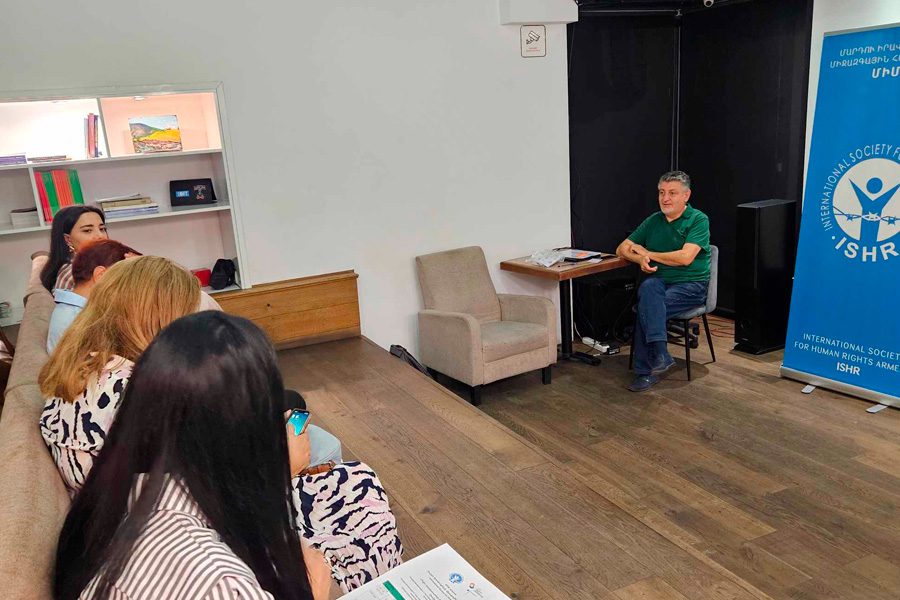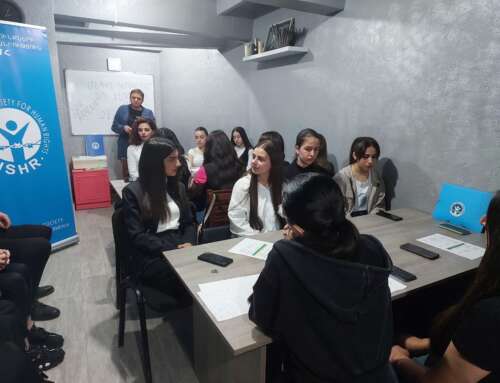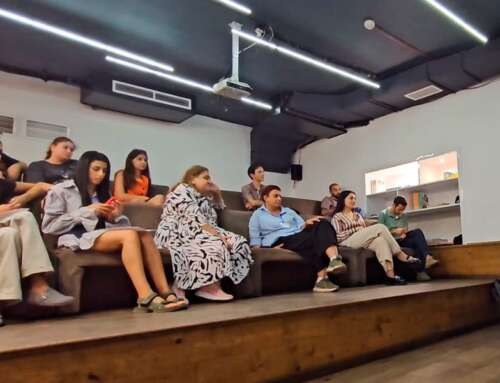The subject of the course was disinformation and its various manifestations in the mass media.
 The main speaker of the topic was Simon Sargsyan, international journalist, https://mitk.am/, the founder and author of the US/EU English-language websites https://JazzBluesNews.com and https://JazzBlues.EU .
The main speaker of the topic was Simon Sargsyan, international journalist, https://mitk.am/, the founder and author of the US/EU English-language websites https://JazzBluesNews.com and https://JazzBlues.EU .
The topic seems to be well-known and has been discussed many times, but in reality, in order to recognize misinformation and not become a victim of its influence, one must be armed with knowledge and have the skills to distinguish fakes.
Since the course has an educational nature and can be a way to avoid misinformation both for the participants of the program and for the general public interested in the topic, we consider it appropriate to quote some passages of fundamental importance from the lecture.
First, the speaker presented the international mechanisms for combating disinformation, highlighting several publicly available platforms.
<<In 2017, the European Union launched the euvsdisinfo.eu resource to combat disinformation spread by Russia. It is conducted in three languages: English, Russian and German. The website has a database of disinformation, in which about 8 thousand examples have been collected (since 2015).
Six former Soviet Union countries are the targets of half of the disinformation messages. Azerbaijan (31), Armenia (80), Moldova (132), Belarus (252), Georgia (345), Ukraine (3193). It is them that Russia wants to keep in its sphere of influence for a long time.
Many of the examples of disinformation used against these countries are aimed at inciting panic, disrupting the domestic political situation, intimidation, or escalating military tensions (in the case of Ukraine). The messages often just seem like nonsense, and often look like outright lies or twisted information. But their efficiency does not decrease from that.”
“Ukraine faced the highest level of disinformation during Russia’s annexation of Crimea and invasion of Donbass. They were hybrid propaganda tools in the media and social networks,” says Kristina Zelenyuk, a political commentator of the Ukrainian online media “Сегодня”.
According to Armenian media expert Samvel Martirrosyan, the disinformation market is extremely large, and good specialists work there, who are constantly looking for new tools and methods to manipulate people.
“Today, it is possible to spread panic within hours using social media. Information spreads so fast that it is almost impossible for people to identify misinformation,” says Samvel.
In March 2020, the European External Action Service published a special report entitled “Coronavirus disinformation”, which included a separate section on “pro-Kremlin disinformation”.
In February-March alone, more than 110 examples of coronavirus disinformation spread by pro-Russian media were recorded in the database of the EUvsDisinfo resource. These examples are consistent with the Kremlin’s traditional strategy of sowing mistrust and chaos, and deepening crisis situations and issues of public concern. Moreover, disinformation intended for the Russian audience characterized the virus as a form of external aggression, claiming that the coronavirus originated in secret American or Western laboratories. Disinformation aimed at an international audience focused on conspiracy theories about “global elites” purposefully using the virus as a weapon to achieve their goals.
WHAT IS DISINFORMATION?
“Disinformation is the intentional dissemination of false or distorted information with the intent to deceive or manipulate, but the actual goals can be diverse, from political and social influence to financial fraud.”
TYPES OF DISINFORMATION:
FAKE NEWS
Fake news is created to cover up the real thing, create panic, etc., because a large number of news, many of which contradict each other, creates information chaos and a person who does not have enough knowledge and skills to filter information, distinguish the right from the wrong, finds himself in a dead end. in.
FAKE PHOTOS AND VIDEOS
We often come across fake photos or edited videos. “I will only believe what I see with my eyes”, when a person sees an event with his own eyes, not reading about it, the chances of believing are greater, because the person neither listens to what is told to him, nor reads about it, he really sees those episodes, but the emergence of various tools in the 21st century casts doubt on many pictures and videos, as it is not difficult to fake them.
POLITICAL DISCLAIMER
In politics, as in all other fields, false information is used to manipulate public opinion.
HOW TO DISCOVER MISINFORMATION?
Always check the source of the information you receive and visit that trusted source to make sure the information is true or not, as false information is often spread by the public on behalf of trusted individuals, organizations and government infrastructure.
Increase your media literacy level and learn to distinguish true from false information.
Be careful on the Internet, do not disclose personal information and be careful of suspicious links. In order to help our Artsakh compatriots, a huge amount of personal data has appeared in the information field, which can be used by the enemy.
Many people think that talking about disinformation is no longer relevant, because the part of society that believes in it is decreasing. In fact, this opinion does not correspond to the reality, because even fact-checking specialists are not always able to immediately distinguish the correct information from the false one.
The stories about aliens, werewolves or the flat earth are very primitive examples of disinformation and have been out of practice for a long time. The disinformation spread today is mostly very successfully packaged as credible and true information, therefore, some skills are needed to identify it.
People have very different purposes for spreading false information. Some do it to make money, others try to manipulate people, influence their decisions, spread their beneficial ideas, etc.
Clickbait is a fairly common type of disinformation. Sensational stories, shocking photos. anything that will make the reader click on the material and go to the website. This option is used to attract as many advertisers as possible. The more visits to the site, the more interested the brand is in placing ads on that site. For this purpose, many mushroom sites are created daily. As a rule, after serving their purpose, they are deleted and replaced by new ones.
Political, civil, public or other groups are in the first ranks of disinformation spreaders. In this case, their goal is to spread their beneficial information and ideas by manipulating people, publishing false information, in other words, propaganda. Especially those forces that have ample financial opportunities can afford to establish one or more media organizations, which become the conduit through which the given force communicates the information that suits them.
There are many such media in Armenia, and often any TV channel or news website is associated with a specific political force. Such media can never be considered independent, whether from the ruling or opposition wing. Any biased information that is out of context or distorted in favor of the publisher is considered misinformation. Such media are particularly active during important political events and reach their peak during elections.
Another interesting type of disinformation is content containing satire and humor. Unlike other types of disinformation, this is not intended to mislead people. Through satire, the authors make fun of various phenomena, events or, as often happens, politicians. Despite all this, sometimes people take such information seriously and spread it. Nowadays, however, politicians often say such nonsense that it is really difficult to distinguish whether it is satire or what was actually said.>>
The lecture was accompanied by active discussions, the participants of the Media Group expressed their views on this or that manifestation of misinformation.
<< Unintentional misrepresentation of facts is also a manifestation of disinformation. In English it is called misinformation. When preparing articles or current news, journalists often do not have enough time to check the facts, do not study the topic in depth and therefore present inaccurate facts or outdated data. This does not mean that they wanted to mislead the reader, but simply that they were too lazy to do their job properly. In any case, journalists can also get confused, it is important to show good faith and correct unintentional mistakes in time.
Those who create disinformation usually know in advance which section of society they are targeting. Those people who tend to believe any kind of information, do not have preferred reliable media and, for example, perceive Facebook as a source of information, are potential targets of misinformation. In most cases, it doesn’t even matter how high a person’s educational level is. it often happens when professionals and teachers of any field spread disinformation content, therefore the essential thing here is the lack of critical thinking and not the educational censorship.
In a war situation, in case of border tension, misinformation and unverified information can have serious consequences.
One of the residents of Vardenis committed suicide after hearing the news about his son’s death. After the suicide, the information was denied. This case highlighted the severe consequences of the challenges in the field of information security.
Among the publications of the Russian press, one can find articles with the following text: “Americans can create a biological weapon”, “Georgia deliberately infects mosquitoes and sends them to Russia”, “Data on mass deaths in Georgian laboratories was published”.
No, these are not clichés taken from Hollywood thrillers about the apocalypse, as you might think. These are excerpts from Russian media reports about the Richard Lugar Public Health Research Center in the suburbs of Tbilisi. This laboratory works in partnership between Georgia and the USA. But the activities of the center, for some reason, are of particular concern to Russia, which is simply “bombing” the laboratory through disinformation and propaganda.
“In September 2018, the whole world was talking about Russia’s use of the Novichok nerve agent on the territory of Great Britain. At the same time, Russia was talking about the Lugar laboratory as a place where the US was allegedly preparing biological weapons against the Russian Federation,” said Sopo Gelava, researcher at the Georgian Media Development Fund.
If you type the phrase “Lugar Lab” into the search box on Google or YouTube, you will see that most of the scaremongering news about it has been produced by the Russian media itself. To overcome those myths, Lugar’s lab opened its doors and revealed what goes on inside.
“The laboratory has received more Russian journalists than Georgian ones. And they were allowed to enter all rooms and buildings,” says Pata Imnadze, deputy director of the National Center for Disease Control in Georgia.
But even the constantly organized open tours of the laboratory did not help the Russian propaganda media to change their information agenda. For example, the Russian news agency “Sputnik” described the “open day” organized by the laboratory with disdain and mistrust.
Of course, none of the “screaming” statements from the Russian media about Lugar’s lab were true, and they were all denied by health professionals. But they achieved the desired result. 20% of Georgians believe that the laboratory contributes to the spread of epidemics. This is how disinformation works in the post-truth era.
The material aroused the great interest of the participants, the course was conducted in the format of interactive discussion, question and answer between the speaker and the participants, expression of opinions, debates.
The next sections of the seminars were aimed at the discussion of the materials proposed and prepared by the young people participating in the program. Thanks to effective courses and the initiative of young people, more than 30 articles of a legal, social, and social nature were prepared, as well as stories of women who emigrated from Artsakh.
The summary video of the course and discussion is also available on the website.
The IDP program is funded by the German Ministry of Foreign Affairs.

MPV team








Leave A Comment